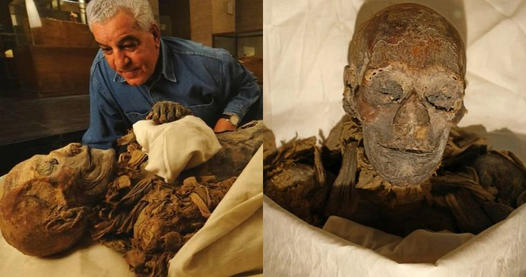In the storied annals of Egyptology, few discoveries have captured the imagination quite like the mummy of Hatshepsut, a powerful and enigmatic figure from ancient Egypt’s new Kingdom. Found by the renowned archaeologist Howard Carter in KV60, located in the legendary Valley of the Kings, the mummy of Hatshepsut offers a fascinating glimpse into the life and health of one of Egypt’s most illustrious queens.

Hatshepsut, the second known female pharaoh in Egypt’s history, ruled during the 18th dynasty, ascending to the throne around 1478 BC. Known for her ambitious building projects and successful trade expeditions, she reigned with wisdom and astuteness, earning her place as one of Egypt’s most celebrated rulers.
The discovery of Hatshepsut’s mummy came as a pivotal moment in Egyptology. During the assembly of unidentified mummies with their right arms placed across their chests – a traditional royal posture for Egyptian mummies – as part of the Egyptian Mummy Project, Hatshepsut’s remains were among those chosen for further study.
Through the marvels of modern technology, her mummy underwent examination via CT-scan, allowing researchers to peer beneath the centuries-old wrappings and into the secrets of her ancient remains. The findings provided new insights into the life and health of this remarkable queen.

The analysis revealed that Hatshepsut had lived to the age of approximately fifty years, a significant achievement for her time. Moreover, it shed light on her health, indicating that she had been obese, and had likely suffered from diabetes and cancer. Such revelations offered a rare glimpse into the ailments that affected even ancient royalty, underscoring the universality of human health concerns throughout history.
The mummy of Hatshepsut now rests in the esteemed Egyptian Museum in Cairo, where it continues to captivate and inspire visitors from around the world. Surrounded by the artifacts and relics of ancient Egypt’s illustrious past, Hatshepsut’s mummy serves as a poignant reminder of the enduring legacy of this remarkable queen and the rich tapestry of Egypt’s royal history.

The discovery and study of Hatshepsut’s mummy also serve as a testament to the power of modern archaeology and technology in unlocking the secrets of the past. Through careful examination and analysis, the mysteries of history are gradually unveiled, painting a vivid picture of the lives and struggles of those who once walked the sands of ancient Egypt.
The story of Hatshepsut’s mummy stands as a testament to the allure and fascination of Egypt’s ancient civilization, a civilization that continues to capture the imaginations of scholars, researchers, and travelers alike. As we continue to explore and learn from the remnants of the past, we come to appreciate the indelible impact of Egypt’s pharaohs and queens, whose legacies endure through the ages. Hatshepsut’s mummy remains an iconic symbol of that timeless heritage, inviting us to delve further into the mysteries that lie beneath the sands of time.